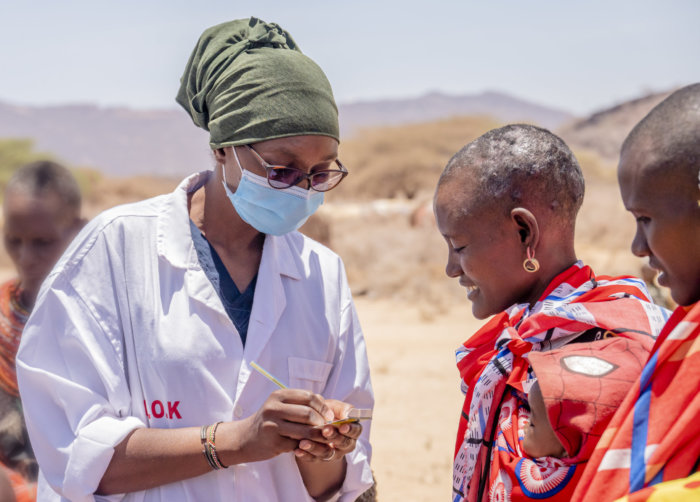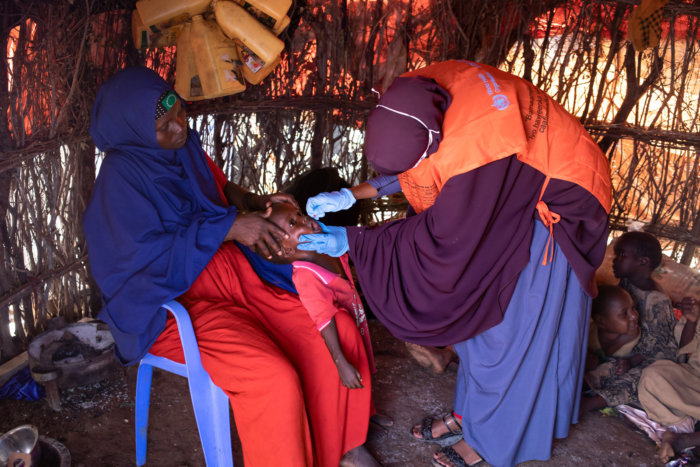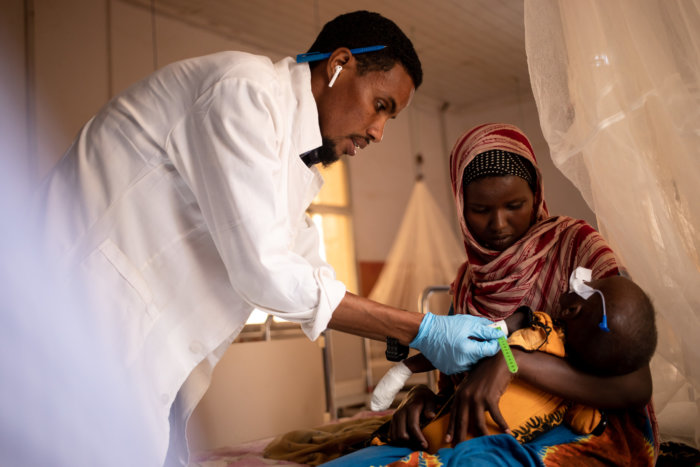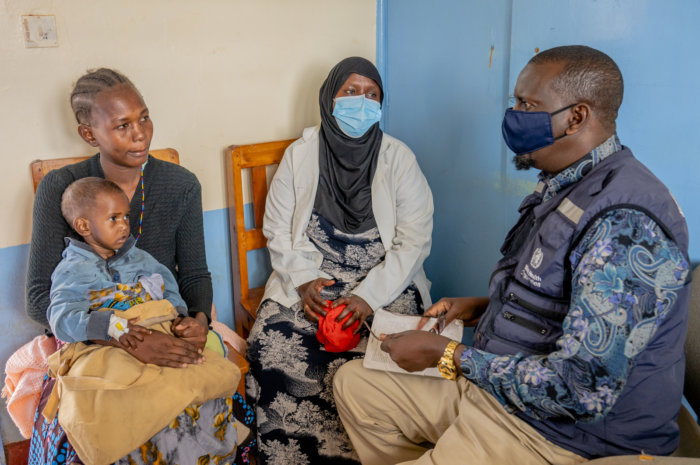UHC Day: How WHO is supporting a healthy future for all in the greater Horn of Africa
In 2012, member states endorsed the right of people to Universal Health Coverage. On 12 December every year, UHC Day, WHO reminds the world of their commitment to providing health coverage at every stage of life.
At the WHO Foundation, we support WHO’s mission and raise resources to help people to enjoy good health and well-being. In the face of widespread food and water shortages in the greater Horn of Africa and the Sahel, WHO is supporting health ministries to treat people with malnutrition and waterborne disease, run vaccination campaigns and organize surveillance to trace outbreaks of measles, malaria, and other infectious diseases.
To mark UHC Day, we share moments from the work of WHO in the current Greater Horn of Africa hunger crisis. They represent the best of health providers’ efforts to help people access quality healthcare in uniquely difficult times.

© WHO / Billy Miaron
“I have been working with these communities for the last five years,” said Mary (left), a Kenyan nurse in Marsabit County, on 23 September 2022, as she wrote a prescription for a woman visiting a mobile health clinic in Ntiliya village.
“This is the toughest one for me as a health worker. Communities that we support are on the move because of the drought. Many children are missing their essential vaccines because parents are moving them with their livestock. In response, we are carrying out mobile activities, following the families wherever they are. We are screening children for malnutrition. Many are not in good shape, they are in need of nutritious food. We are giving them nutrition supplies provided by UNICEF. I am happy that our Community Health Volunteers are able to trace where communities are moving and enable us to find children who have missed their vaccines. But this movement requires resources. The distances to be covered are vast.“
Millions in the greater Horn of Africa are facing acute hunger as the region faces one of the worst droughts in recent decades. Many people have left their homes in search of food and water, and pasture for animals. Large-scale displacement is often accompanied by a deterioration in hygiene and sanitation. Outbreaks of infectious diseases are a major concern, especially when combined with low existing vaccination coverage and health service availability.
As people become increasingly food insecure, they also must make the impossible choice between food and healthcare, even as nutritional deficiencies make them increasingly vulnerable to disease. This is particularly true for children, for whom the combination of malnutrition and disease can prove fatal.

© WHO / Ismail Taxta
Wardo Mohamud Abdirizak is a health worker and vaccinator. On 9 November 2022, she participated in house-to-house visits at Ramadey Internally displaced people (IDP) camp in Baidoa, Somalia. Her mobile health team is supported by WHO.
Somalia is currently experiencing an escalating drought that has affected 7.8 million people and displaced 1.1 million in search of food, water, and humanitarian assistance.
An estimated 4.3 million people (26% of total population) are experiencing severe food crises or worse, including 121,000 people in a catastrophe (IPC 5) level.
33% of the children below 5 years of age suffer from severe acute malnutrition with medical complications. The effects of food insecurity and drought are further compounded by protracted conflict and lack of access to healthcare for most of the population.
WHO is providing life-saving assistance in drought- affected areas, working with families, local communities, and governments throughout Somalia.

© WHO / Ismail Taxta
29 years-old Hawo Mohamed brings her child for vaccination in the Baidoa IDP camp.
WHO supports a network of Community Health Workers as well as Rapid Response Teams who provide basic health services to the displaced population in the area. Services include malnutrition screening, vaccination, and referral to hospitals for advance care if needed.

© WHO / Ismail Taxta
On 8 November 2022, two-year-old Maryam was brought to the Bay Regional Hospital in Baidoa, Somalia. A doctor measures her forearm to check on her nutrition status.
Abdurahim was admitted to Bay Regional Hospital due to severe malnutrition. After a week of treatment, he started to slowly improve.

© WHO / Ismail Taxta
Amina Mohamud Ma’alin holds her malnourished son Abdirashid, 8- months-old, in Bay Regional Hospital in Baidoa, Somalia.
After separating from her husband during the onset of the drought, Amina, 28, took on the role of raising her two girls and three boys. As a livestock keeper and a farmer in the rural Bakool region, Amina supported her entire family with only a small plot of farmland and five cows. The cows’ milk provided a modest income for the family until the end of 2021, when the region experienced three consecutive seasons with little to no rainfall. This led to water sources drying up, pasture land disappearing, crops failing and the family losing all of their assets, including five cows. With no income sources remaining for their family, and facing the threat of famine, Amina and her husband divorced, and she left her home village in the Bakool region to travel over 130 kilometers to Baidoa city in hope of finding help for herself and her children.
Arriving with only what she could carry, Amina settled at Bakar Yare Camp in Baidoa, an already an overcrowded settlement. Amina found herself going days without eating and relied completely on friends and neighbors for the little support they could give her. “Sometimes my children and I opt to skip breakfast, eat lunch with an unbalanced diet, then skip supper until the following day,” she said.
“I have been in the hospital for seven days because my youngest son is suffering from malnutrition. He can’t eat anything, he is being fed at the hospital and his condition is getting better now.”

© WHO / Billy Miaron
Teresa (left) traveled from Loyiangani, 300 kilometres away, to seek help for her son Damaris, who was suffering from malnutrition and other medical complications. On 21 September 2022, WHO’s Dr Adam Haj (right) spoke to Teresa and Dr Guyatu (centre) during a consultation session in Marsabit County Referral Hospital.
Millions in the greater Horn of Africa are facing acute hunger as the region faces one of the worst droughts in recent decades. Many people have left their homes in search of food and water, and pasture for animals. Large-scale displacement is often accompanied by a deterioration in hygiene and sanitation. Outbreaks of infectious diseases are a major concern, especially when combined with low existing vaccination coverage and health service availability.
As people become increasingly food insecure, they also must make the impossible choice between food and healthcare, even as nutritional deficiencies make them increasingly vulnerable to disease. This is particularly true for children, for whom the combination of malnutrition and disease can prove fatal.
WHO and partners are working to counter the consequences of malnutrition, respond to disease outbreaks, and ensure that essential health services can continue.
To support and donate to WHO’s Emergency Health Appeal for the greater Horn of Africa and the Sahel, visit hoa-sahel.who.foundation.

